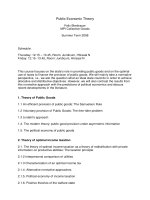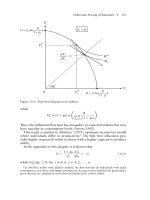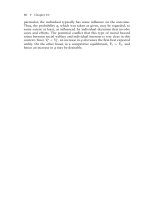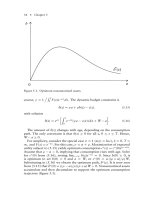Public Economic Theory Felix Bierbrauer MPI Collective Goods
Bạn đang xem bản rút gọn của tài liệu. Xem và tải ngay bản đầy đủ của tài liệu tại đây (9.41 KB, 3 trang )
Public Economic Theory
Felix Bierbrauer
MPI Collective Goods
Summer Term 2008
Schedule:
Thursday: 12.15 – 13.45, Room: Juridicum, Hörsaal N
Friday: 12.15 -13.45, Room: Juridicum, Hörsaal N
This course focuses on the state’s role in providing public goods and on the optimal
use of taxes to finance the provision of public goods. We will mainly take a normative
perspective, i.e., we ask the question what an ideal state could do in order to achieve
allocative and distributive objectives. However, we will also contrast the results from
this normative approach with the predictions of political economics and discuss
recent developments in the literature.
1. Theory of Public Goods
1.1 An efficient provision of public goods: The Samuelson Rule
1.2 Voluntary provision of Public Goods: The free-rider problem
1.3 Lindahl’s approach
1.4. The modern theory: public good provision under asymmetric information
1.5. The political economy of public goods
2. Theory of optimal income taxation
2.1. The theory of optimal income taxation as a theory of redistribution with private
information on productive abilities: The taxation principle
2.1.2 Interpersonal comparison of utilities
2.1.3 Characterization of an optimal income tax
2.1.4. Alternative normative approaches
2.1.5. Political economy of income taxation
2.1.6. Positive theories of the welfare state
3 Theory of optimal commodity taxation/ Ramsey taxation
3.1. The theory of optimal commodity taxation as a theory of public sector pricing
3.2. Renegotiation-proofness as a theoretical foundation of linear tax systems
3.2 Characterization of an optimal commodity tax system
3.3 Application: Theory of optimal capital taxation
4. The relation between optimal income taxation and optimal commodity
taxation
4.1 The critique of Atkinson and Stiglitz
4.2 New Dynamic Public Finance
5. The theory of optimal taxation and the theory of public goods
5.1 The modified Samuelson rule
5.2 Optimal income taxation, optimal commodity taxation and public good provision
5.3 A political economy perspective on taxation and public good provision.
6. Taxation of profits
6.1. Competitive equilibrium with constant returns to scale
6.2 Increasing returns to scale
6.3 Tax competition between different countries
7. Externalities
7.1 Pigouvian taxes
7.2 Pigouvian taxes versus quantity controls
8. Public Finance in Models of Economic Growth
8.1. Public Debt and Ricardian Equivalence
8.2 Taxation, Public Good Provison and Economic Growth
8.3 The Pension System
9. The state as a provider of insurance
9.1. Sources of market failure on insurance markets
9.2. Government intervention on insurance markets
References
As main reference I recommend the textbook of Hindriks and Myles, Intermediate
Public Economics, MIT Press, 2006. This book covers all topics at a level that is not
too demanding from a mathematical point of view.
Other useful references are:
Salanie, The economics of taxation, MIT Press, 2003
Atkinson and Stiglitz, Lectures on Public Economics, Mc Graw-Hill, 1980
Myles, Public Economics, Cambridge University Press, 1995
For more specific topics:
Bolton and Dewatripont, Contract Theory, MIT Press 2006 is useful for Chapters 1.4,
2 and 9
Mas-Collel, Whinston, Green, Microeconomic Theory, Harvard University Press 1996
is useful for Chapter 1.4
Barro and Sala-i-Martin, Economic Growth, MIT Press, 2004 is useful for Chapter 8
If textbook treatments are not available I will rely on original journal articles as a
reference. These references will be given during the lectures.









